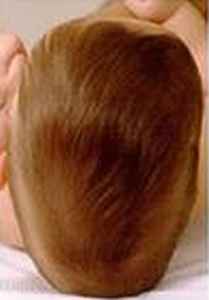

MedFriendly®


Dolichocephaly
Dolichocephaly is a condition in which one has an abnormally
long head. A "perfectly round" head measures the same distance
between the ears as it does from the nose to the back of the
head. In dolichocephaly, the front to back measurement is longer
than the side-to-side measurement.
HOW IS DOLICHOCEPHALY DIAGNOSED?
The first sign that will lead to diagnosis is an abnormally long
skull. The front and back parts of the skull are most noticeable
and the sides of the back of the skull are not as noticeable as
they should be.
FEATURED BOOK: Principles of Neurology by Adams and Victor
The doctor will take a history about the infant from the parents or guardians. The history
will focus on the mother's pregnancy, the position of the developing baby during
pregnancy, premature birth (being born too early), birth trauma, multiple births, and the
baby's sleeping position. X-rays and measurements of the skull are taken to make an
exact diagnosis.
Technically, dolichocephaly is defined as a skull with a cephalic index of 75 or less. The
cephalic index is a rating scale that is used to measure head size. The cephalic index
rating is obtained by multiplying the maximum width of the head by 100 and dividing that
number by the maximum length of the head. A cephalic index between 76 and 80 is
considered normal. The lower the number gets on the cephalic index, the longer the skull
is.
"Where Medical Information is Easy to Understand"™
WHAT CAUSES DOLICHOCEPHALY?
Normally, as an infant's brain grows, open borders (known as
sutures) between the bones of the skull expand and lead to the
development of a normal head shape. If one or more of these
sutures close early, it will cause the skull to expand in the direction
of the sutures that remain open, which can result in an abnormal
head shape. In dolichocephaly, the sagittal sutures (which run from
the front of the head to the back) close together too early. This
closure prevents the skull from expanding in width, and the skull
begins to expand towards open sutures (such as the coronal
sutures that run down the side of the head).
The result is that the skull takes on a long, narrow, and boat-shaped appearance. A ridge (raised area)
may be noticeable by the closed sagittal sutures. Abnormal skull shapes can occur due to positioning of
the developing baby during pregnancy, abnormal sleeping position, or from neck tightness.
CAN DOLICHOCEPHALY AFFECT BRAIN DEVELOPMENT?
Yes. In severe cases, dolichocephaly can result in increased pressure on the growing brain, leading to
brain impairment and mental retardation. Pictures of the brain can be taken with CT (Computerized Axial
Tomography) scans to determine if there are any abnormalities.
IS DOLICHOCEPHALY SERIOUS?
Dolichocephaly is not always serious, since the condition ranges from mild to severe. In fact, most
children who are treated for dolichocephaly with surgery (see below) go on to lead normal lives. However,
dolichocephaly is associated with dozens of developmental disabilities that can result in mental
retardation. Psychological problems such as poor self-esteem and depression can also occur as the child
gets older. An abnormal skull shape can also lead to difficulties with chewing, swallowing, vision, and
breathing. The longer the skull, the greater the risk of serious associated problems.
HOW IS DOLICHOCEPHALY TREATED?
Since dolichocephaly is due to the sagittal sutures closing too early, treatment involves removing bone
from the middle of this suture. The surgery works best when done before nine months of age. The surgery
is usually very successful and causes the skull to take on a more normal shape. A cut or opening is made
behind the hairline so there is no visible scar after the surgery because it will be covered by the hair. The
hair is not shaved during the surgery. After the surgery, the total hospital stay is usually about three to
four days. The eyes and forehead swell after the operation and the eyes are actually swollen shut for a
few days. In general, children typically tolerate the surgery very well.
IS DOLICHOCEPHALY VERY NOTICEABLE?
Dolichocephaly can be very noticeable. How noticeable dolichocephaly is, however, depends on the
seriousness of the condition. The greater the length of the skull compared to its width, the more noticeable
it is. The more noticeable the condition, the greater the risk of associated problems such as mental
retardation, poor-self esteem, and depression.
HOW MANY INFANTS ARE BORN WITH DOLICHOCEPHALY?
About 1 in 4200 babies are born with dolichocephaly.
WHAT OTHER WORDS ARE RELATED TO DOLICHOCEPHALY?
Dolichocephaly is also known as dolichocephalism, cymbocephaly, tectocephaly, sagittal synostosis,
scaphocephalis, scaphocephalism, mecocephaly, and scaphocephaly. The following words mean
pertaining to dolichocephaly: dolichocephalic, dolichocephalous, and dolichocreanial. Compare
dolichocepahly to brachycephaly (a short broad head), mesocephaly (medium sized head), microcephaly
(abnormally small head), and macrocephaly (abnormally large head).
WHY IS IT CALLED DOLICHOCEPHALY?
Dolichocephaly comes from the Greek word "dolichos" meaning "long," and the Greek word "kephale"
meaning "head." Put the words together and you have "long head."















